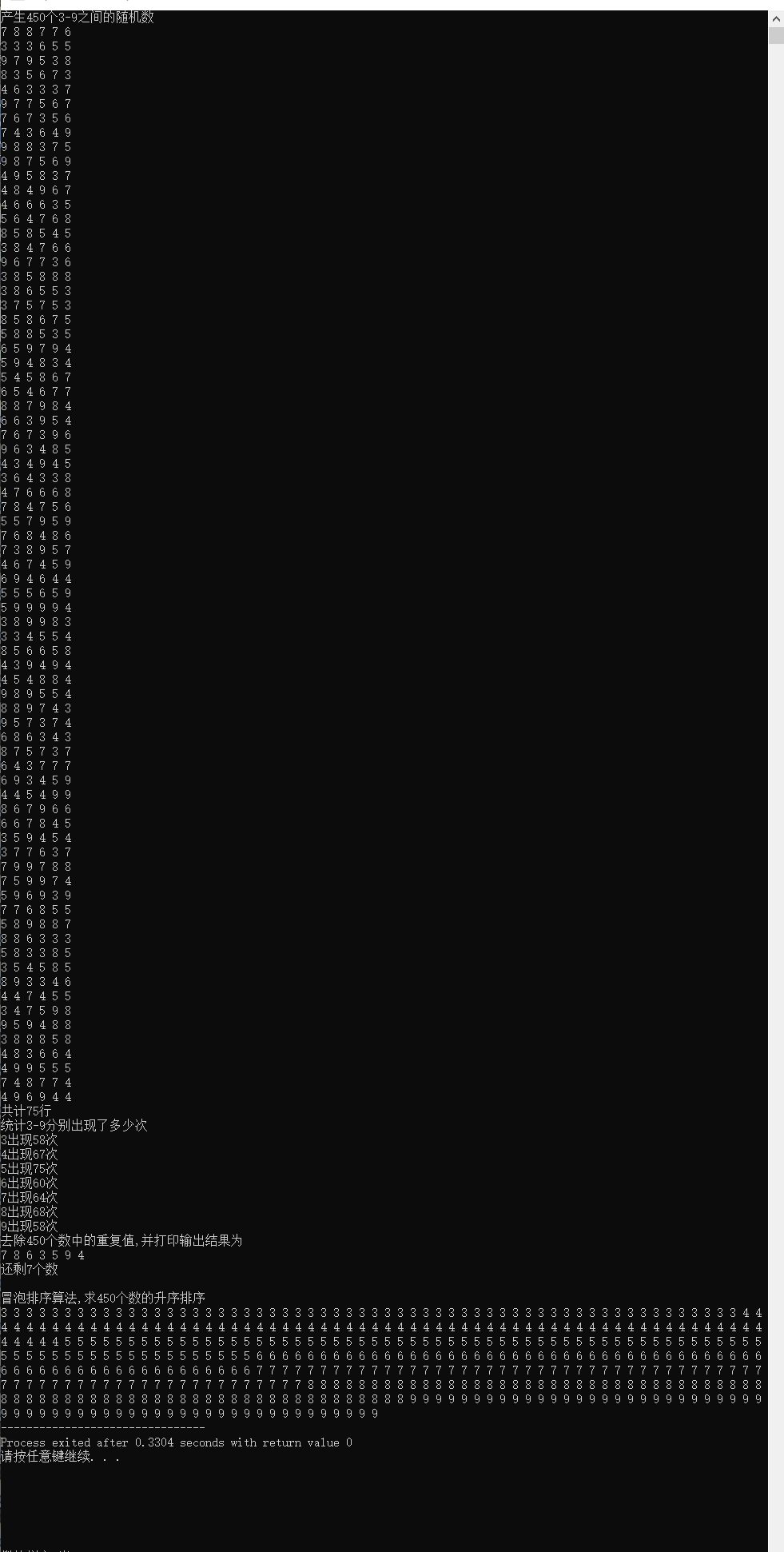目录
- 1.题目详情:生成一定范围内的随机数
- 2.解题小知识
- 3.产生3-9之间的随机数
- 4.统计3-9分别出现了多少次
- 5.去除450个数中的重复值,并打印输出
- 6.冒泡排序算法,求450个数的升序排序
- 7.完整代码C++
- 8.结果
1.题目详情:生成一定范围内的随机数
- 借助随机生成函数3-9之间任意整数450个,将结果显示到屏幕上,每6个一行
- 统计3-9分别出现了多少次
- 去除450个数中的重复值,并打印输出
- 冒泡排序算法,求450个数的升序排序
2.解题小知识
srand((unsigned int)time(0));
int a = rand() % 51 + 13; 产生13~63的随机数 分析:取模即取余, rand()%51+13我们可以看成两部分: rand()%51是产生 0~50 的随机数,后面+13保证 a 最小只能是13,最大就是 50+13=63。
3.产生3-9之间的随机数
//产生3-9之间的随机数
void randomNumber(int arr[], int b[], int n) {
int j = 1, a = 0, count = 0;
//int arr[450] = {0};
//srand((int)time(0));
srand((unsigned int)time(0));
cout << "产生450个3-9之间的随机数" << endl;
while (j <= n) {
//产生3~9的随机数
a = rand() % 7 + 3;
cout << a << " ";
//如果是每行是6个,则换成下一行
if (j % 6 == 0){
cout << endl;
count++;
}
//arr[]和b[]存储产生的随机数
b[j - 1] = arr[j - 1] = a;
j++;
}
cout << "共计" << count << "行"<<endl;
}
4.统计3-9分别出现了多少次
//统计3-9分别出现了多少次
int Count_x(int arr[], int n) {
int count[1001];
for (int i = 0; i < n; i++) {
switch (arr[i]) {
case 3:
count[3]++;
break;
case 4:
count[4]++;
break;
case 5:
count[5]++;
break;
case 6:
count[6]++;
break;
case 7:
count[7]++;
break;
case 8:
count[8]++;
break;
case 9:
count[9]++;
break;
}
}
cout << "统计3-9分别出现了多少次" << endl;
for (int i = 3; i < 10; i++) {
cout << i << "出现" << count[i] << "次" << endl;
}
return 0;
}
5.去除450个数中的重复值,并打印输出
//去除450个数中的重复值,并打印输出
int removeSame(int arr[], int n) {
int temp;
for (int i = 0; i < n; i++) { //循环判断数组中每一个数
for (int j = i + 1; j < n; j++) { //判断arr[i]后边的数是否和arr[i]相等
if (arr[i] == arr[j]) {
for (temp = j; temp < n; temp++) {
//将arr[j]后面的元素全往前移一个位置
arr[temp] = arr[temp + 1];
}
j--; //arr[j+1]取代a[j]位置,为使下次从arr[j+1]开始查找,j减一(为使j保持不变)
n--; //数组长度减一
}
}
}
cout << "还剩" << n << "个数" << endl;
cout << "去除450个数中的重复值,并打印输出结果为" << endl;
for (int i = 0; i < n; i++) {
cout << arr[i] << " ";
}
return 0;
}
6.冒泡排序算法,求450个数的升序排序
//冒泡排序算法,求450个数的升序排序
int bubblesort(int b[], int n) {
//int temp;
for (int i = 0; i < n - 1; i++) { //确定排序趟数
for (int j = 0; j < n - i - 1; j++) { //确定比较次数
if (b[j] > b[j + 1]) { //若为逆序
//交换
// temp = arr[j];
// arr[j] = arr[j + 1];
// arr[j + 1] = temp;
swap(b[j], b[j + 1]); //交换
}
}
}
cout << "冒泡排序算法,求450个数的升序排序" << endl;
for (int i = 0; i < n; i++) {
cout << b[i] << " ";
}
return 0;
}
7.完整代码C++
#include<bits/stdc++.h>
using namespace std;
/*
生成一定范围内的随机数
1.借助随机生成函数3-9之间任意整数450个,将结果显示到屏幕上,每6个一行
2.统计3-9分别出现了多少次
3.去除450个数中的重复值,并打印输出
4.冒泡排序算法,求450个数的升序排序
*/
/*
srand((unsigned int)time(0));
int a = rand() % 51 + 13;
产生13~63的随机数
分析:取模即取余,
rand()%51+13我们可以看成两部分:
rand()%51是产生 0~50 的随机数,后面+13保证 a 最小只能是 13,最大就是 50+13=63。
*/
//产生3-9之间的随机数
void randomNumber(int arr[], int b[], int n) {
int a = 0, count = 0;
//int arr[450] = {0};
//srand((int)time(0));
srand((unsigned int)time(0));
cout << "产生"<<n<<"个3-9之间的随机数" << endl;
for (int j = 1; j <= n; j++) {
//产生3~9的随机数
a = rand() % 7 + 3;
cout << a << " ";
//如果是每行是6个,则换成下一行
if (j % 6 == 0) {
cout << endl;
count++;
}
//arr[]和b[]存储产生的随机数
b[j - 1] = arr[j - 1] = a;
}
cout << "共计" << count << "行" << endl;
}
//统计3-9分别出现了多少次
int Count_x(int arr[], int n) {
int count[1001];
for (int i = 0; i < n; i++) {
switch (arr[i]) {
case 3:
count[3]++;
break;
case 4:
count[4]++;
break;
case 5:
count[5]++;
break;
case 6:
count[6]++;
break;
case 7:
count[7]++;
break;
case 8:
count[8]++;
break;
case 9:
count[9]++;
break;
}
}
cout << "统计3-9分别出现了多少次" << endl;
for (int i = 3; i < 10; i++) {
cout << i << "出现" << count[i] << "次" << endl;
}
return 0;
}
//去除450个数中的重复值,并打印输出
int removeSame(int arr[], int n) {
cout << "去除"<<n<<"个数中的重复值,并打印输出结果为" << endl;
int temp;
for (int i = 0; i < n; i++) { //循环判断数组中每一个数
for (int j = i + 1; j < n; j++) { //判断arr[i]后边的数是否和arr[i]相等
if (arr[i] == arr[j]) {
for (temp = j; temp < n; temp++) {
//将arr[j]后面的元素全往前移一个位置
arr[temp] = arr[temp + 1];
}
j--; //arr[j+1]取代a[j]位置,为使下次从arr[j+1]开始查找,j减一(为使j保持不变)
n--; //数组长度减一
}
}
}
for (int i = 0; i < n; i++) {
cout << arr[i] << " ";
}
cout<<endl;
cout << "还剩" << n << "个数" << endl;
return 0;
}
//冒泡排序算法,求450个数的升序排序
int bubblesort(int b[], int n) {
//int temp;
for (int i = 0; i < n - 1; i++) { //确定排序趟数
for (int j = 0; j < n - i - 1; j++) { //确定比较次数
if (b[j] > b[j + 1]) { //若为逆序
//交换
// temp = arr[j];
// arr[j] = arr[j + 1];
// arr[j + 1] = temp;
swap(b[j], b[j + 1]); //交换
}
}
}
cout << "冒泡排序算法,求"<<n<<"个数的升序排序" << endl;
for (int i = 0; i < n; i++) {
cout << b[i] << " ";
}
return 0;
}
int main() {
int n = 450;
int arr[n];
int b[n];
randomNumber(arr, b, n);
Count_x(arr, n);
removeSame(arr, n);
cout << endl;
bubblesort(b, n);
//sort(arr, arr + n);
return 0;
}
8.结果

本文可以参考另外一篇讲解rand()和srand()产生随机数的

最后
以上就是激昂灯泡最近收集整理的关于生成一定范围内的随机数(c++例题)的全部内容,更多相关生成一定范围内内容请搜索靠谱客的其他文章。
本图文内容来源于网友提供,作为学习参考使用,或来自网络收集整理,版权属于原作者所有。








发表评论 取消回复